Telecell Mobile F55L2 Mobile Phone User Manual
Telecell Mobile (H.K) Ltd. Mobile Phone
User Manual
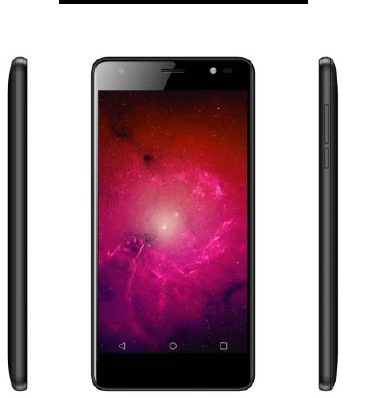
1
ATRIUM II
user manual
2
Table of Contents
Safety Information ....................................................................................................3
Appearance and Key Function ..............................................................................4
Introduction ................................................................................................................6
Call Functions ...........................................................................................................8
Contacts ....................................................................................................................10
Messaging ................................................................................................................13
Internet Browser .....................................................................................................15
Bluetooth ..................................................................................................................17
Camera ......................................................................................................................19
Gallery .......................................................................................................................21
Music ..........................................................................................................................22
3
Alarm Clock ..............................................................................................................24
Settings .....................................................................................................................28
Storage ......................................................................................................................32
Safety Information
Please carefully read the terms below:
Use Safely
Do not use your mobile phone where it might cause danger.
Transportation Safety
Please observe all transportation laws and regulations.
Please drive with both hands on the wheel.
DO NOT TEXT AND DRIVE
Hospitals
Please follow limitations.
Please turn off your mobile phone when near medical instruments.
Airports
Please follow all flight safety regulations and do not use your phone during flight.

4
Toxic Chemicals
Do not use your mobile phone around fuels or chemicals.
Explosion Hazard
Please observe related limitations and do not use your mobile phone around an area where explosions
may occur.
Accessories and Batteries
Please use only Blu authorized accessories and batteries.
Backup
Please remember to keep a written record of all important information.
Water
Your phone is not waterproof. Keep it away from water and liquids.
SOS Emergency Calls
Make sure your mobile phone is switched on and in a service area. In home screen, tap the phone key
and dial 911 and send.
Appearance and Key Function
Volume
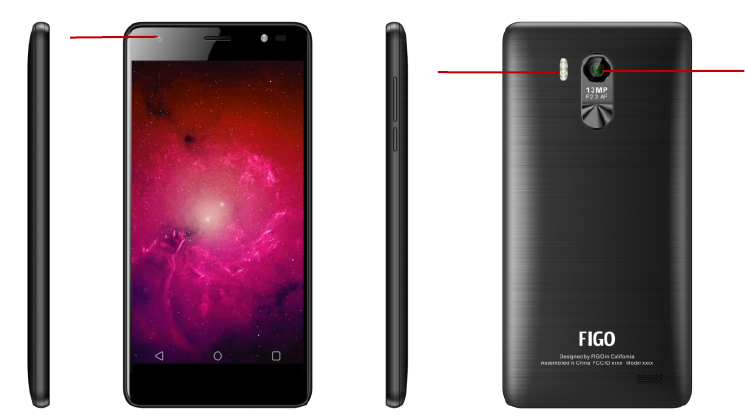
5
Front
Camera
Rear Camera
Flash

6
Introduction
Installation of the SIM Card
Please install the SIM card before using your phone.
Note: Please keep the SIM card out of the reach of children. The SIM card and its contact are easily
damaged due to scratching or bending. Please be cautious when carrying, installing or taking out the
SIM card.
To insert SIM card(s):
1. Switch off the mobile phone and remove the rear cover.
2. Insert the SIM card(s)
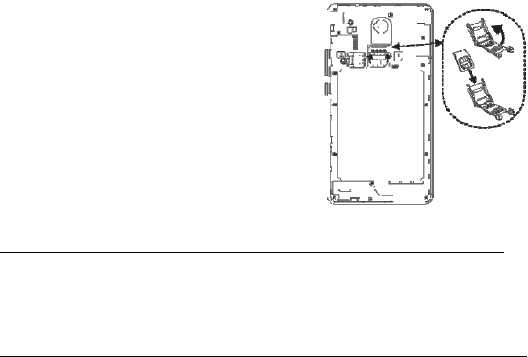
7
3. Replace the rear cover of the mobile phone and power on.
Power On and Off
On - Please ensure the SIM card has been properly inserted into the phone. Long press the Power key
to switch on the phone on.
Off - In standby mode, long press on Power key until an options menu appears. Select OFF in the
menu and confirm
Password Lock
You may set a screen unlock picture or a PIN code lock as a security measure. For further information
SIM Slot
(
s
)

8
regarding password locks, password revision and other functions please enter the security settings of
the phone.
Call Functions
At the dial keyboard, enter the phone number and then click the dial key. You may choose which SIM
card the call will be placed on. If dialing an extension, you may click the dial pad icon in the bottom of
the screen to open the interface and enter the number of the extension. You may also enter an input
number and call contacts through speed dial.
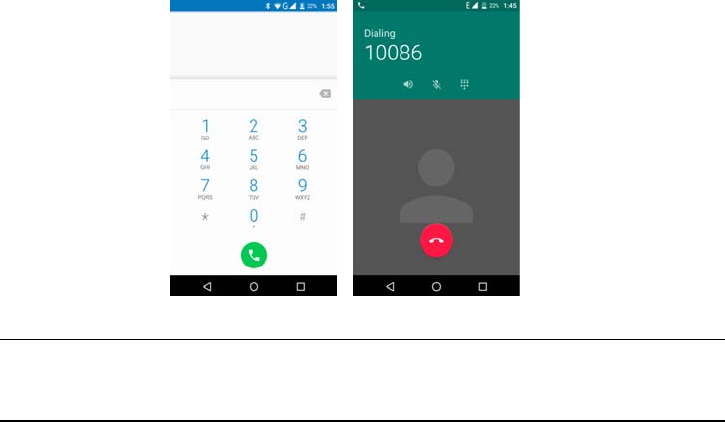
9
Call Logs
Every telephone number called and received will be saved in the phones call log. All numbers in the call
log can be dialed directly by clicking the dial icon on the right side of the screen. When the number
appears on the list, click it to view details.
Proximity Sensor
The proximity sensor determines how far away an object is from the device. During the call or when you
10
place the phone close to the ear, the backlight will turn off automatically which conserves battery and
prevents inadvertently touching.
Contacts
Enter: Click on the applications menu and select contacts
• The default display is the phone contacts and SIM card contacts
• The contacts are organized alphabetically by default.
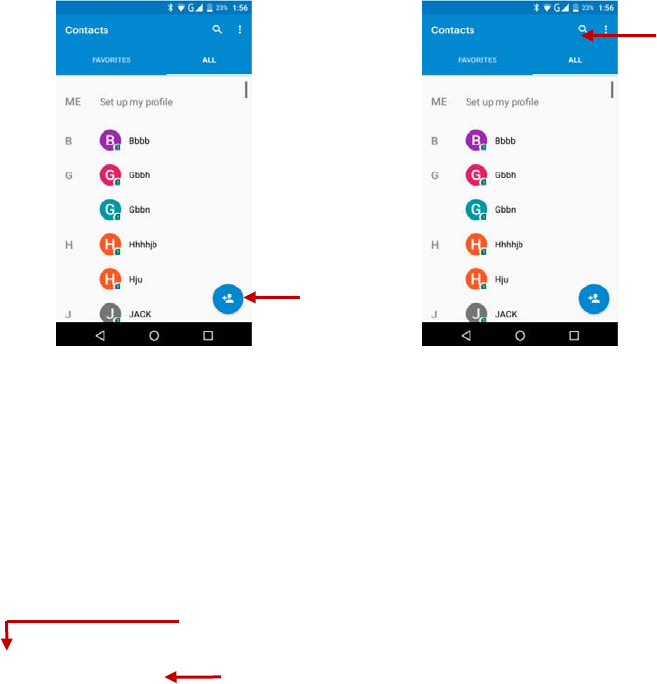
11
Click the Search icon to enter the contact search interface.
Any numbers or letters associated with any of the contacts saved in the list will be shown in
the search results.
If there were no matches for the inputted contact, the interface will display no contacts found.
Add Contact
Search
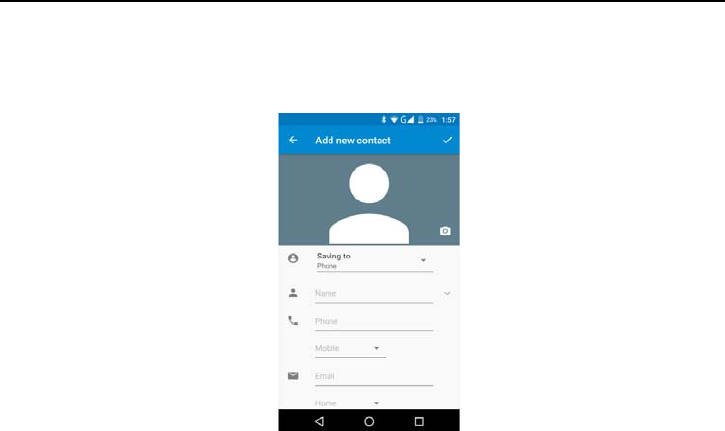
12
Add New Contact
1. Click “Add Contact” icon
2. Select to save contacts to phone or SIM card
3. You may edit contact picture, name, telephone number, group, address, and email among other
options
4. Click to finish and save contact.

13
Messaging
You may use this function to exchange text messages and multimedia messages with your family and
friends. The messages to and from the same contact or phone number will be saved into a single
conversation so you may see the entire message history conveniently.
Send an SMS
Application Menu » Messaging » New message
(or use shortcut icon)
1. Click to enter recipient (You may enter contacts from contact book or enter a new number)
2. Compose Message
3. Send
Send an MMS
When creating message, the default message style is SMS. The message will automatically convert to
MMS when adding an attachment.
1. Click the icon in the messaging interface.
2. Chose to add attachments.
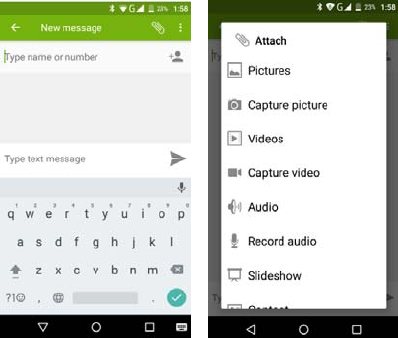
14

15
Internet Browser
Menu Functions
Backward
After browsing through multiple pages, this option will return the user to the previous page.
Forward
After browsing through multiple pages, this option will move to a web page after the current
page.
Windows
You may view all windows open by clicking the windows icon in the upper right part of the
browser.
Bookmarks
Click the Bookmarks option to make the current URL as a saved Bookmark.
Click Bookmarks to opened saved bookmarks.
More
Find on page: Search current page.
Share page: Select to share the current page.
Save for offline reading: Saves page for offline reading.
Page info: Display page address and other information of the current browsing
History: Show your browsing history and view the most visited pages.
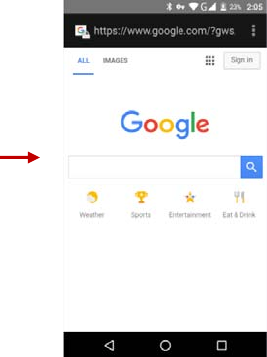
16
Settings: Contains a variety of browser settings.
Browser

17
Bluetooth
Bluetooth is a short-range wireless communications technology that devices can use to exchange
information and connect to different types of devices which include headsets, car kits, and other
devices.
Power on Bluetooth
1) Settings » Wireless & Networks » Bluetooth and select to power on Bluetooth.
2) The Bluetooth icon will appear grey in the in the notification bar, and the phone will start to scan
for all devices within range.
3) In Bluetooth settings all the devices found will displayed in the list under the icon.
Note: The maximum detecting time of the phone is 2 minutes.
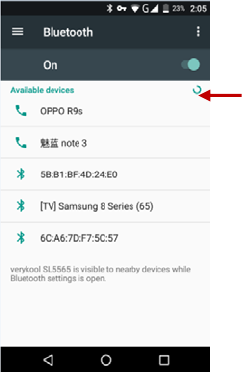
18
List of available
devices
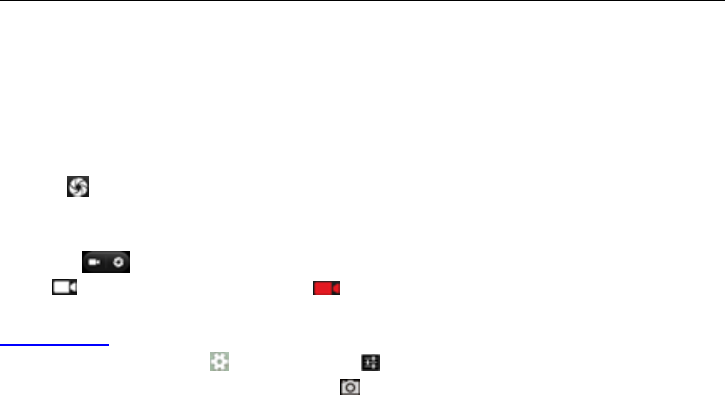
19
Camera
Camera
Prior to use: Install memory card before using the camera or video camera. All photos or videos taken
by the phone are stored in the memory card.
Open Camera
1. Applications Menu » Camera
2. Switch to video mode if you want to record videos.
Note: You may also place a camera shortcut on any of the screens
Take photos
1. In the All Apps screen, touch the Camera icon to open the camera.
2. Tap the icon to take photos after the view is satisfactory.
To view it, slide the screen to the left or just tap the picture in the right corner of the screen.
Record video clips
You can use icon to change from Camera to Camcorder or vice versa.
Tap the icon to start recording and touch the icon to end.
After a video is recorded, you can slide the screen to the left or touch the frame in the corner to view the video.
Camera settings
On the camera screen, touch the icon, and then touch to set GPS location info, Exposure, Color effect,
Scene mode, White balance and Anti-flicker. Touch to set Face Detection, Self timer, Continuous shot,
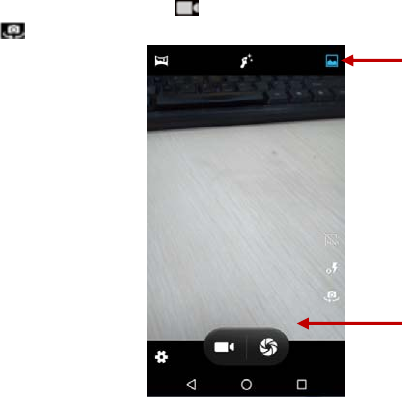
20
Picture size and Preview size. Touch to set Microphone, Audio mode and Video quality.
Touch the icon to change to the back or front camera.
Select from
Camera or Video
Camera Options

21
Gallery
Open Images
Applications Menu » Gallery
Share Pictures
You may share pictures by sending them through Gmail or the E-mail application. You may also send
pictures through the MMS message function by composing a message and attaching the picture. Any
image can also be sent via the Bluetooth function by selecting Bluetooth equipment that has been
paired.
Adjust Image
Press Menu and Edit to adjust images
Edit light: Fill Light, Highlights, Shadows, Auto-Fix.
Edit image effects: Cross-process, Posturize, Logo, Documentary, and Fish Eye.
Color Effects: Warmth, Saturation, B&W, Sepia, Negative, Tint, Duo-tone, Doodle.
Crop: Crop, Red Eye, Straighten, Rotate, Flip, Sharpen.
View Images
In the picture interface, click on an album to view images
You can choose to display small or large thumbnails. In the photo album, scroll the picture towards left
to view the next picture or towards right to view the previous one.
Crop Pictures

22
1. If you want to adjust the size of the picture, use the crop tools. Once the arrow appears, pinch your
fingers in or out to adjust the size.
2. If you want to adjust the image and keep its proportion, please hold down any of the four corners of
the image and adjust.
Music
Open Music
Application Menu » Music
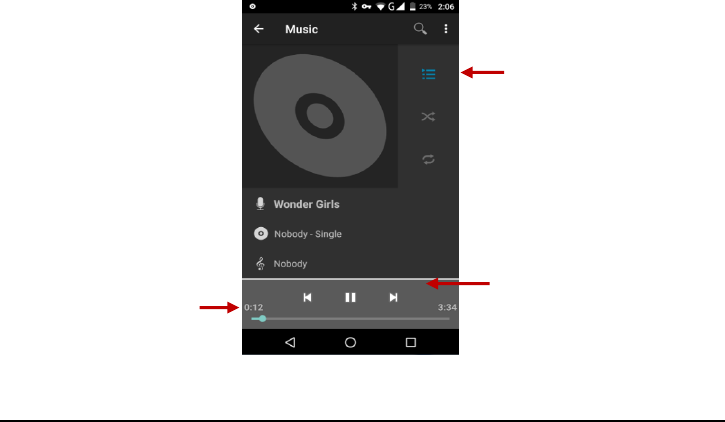
23
Search Music
You may choose to search for music from media folder through artist name, song name, album name.
Song Status
Song Controls
Player Options
24
The following formats are available: AMR, M4A, MIDI, MP3, WAV, and OGG.
Alarm Clock
1. Click on the Clock icon in the application menu
2. Click set alarm button and enter the alarm clock set interface where you may add and edit alarms
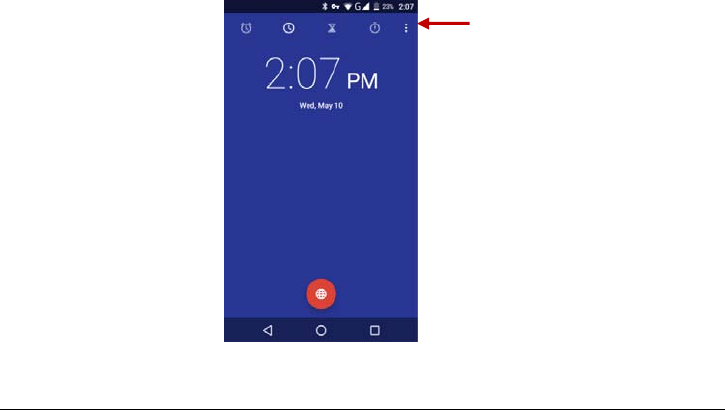
25
FM Radio
FM Radio
Through this function, you may listen to FM radio on the device. The FM radio uses the wired
headphones as an antenna in order to receive signal. Before using this function, connect the original
Click to add, edit
or delete alarms

26
equipment headphones that came with the phone.
Open FM radio
Press the FM Radio icon to open the application.
- Tap or to scan for available FM channels.
- Tap / to change the frequency by +/–0.1 MHz.
- Press the Volume Keys to adjust the volume.
- Touch to select preset list.
- Touch to switch off the radio.
- Touch to search radio channels, choose the sound from speaker and record FM.
- Touch to add to favorites/remove from favorites.
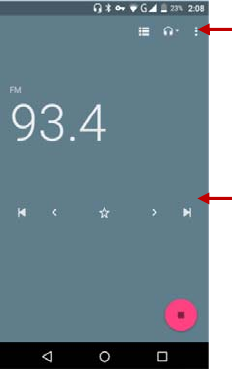
27
Radio
Options
Scan

28
FM Radio as Background
Click on the Home key to move the FM Radio program to the background.
Settings
Wi-Fi / WLAN
Wi-Fi » Wi-Fi settings » Click Wi-Fi to power on. When switched on, the Wi-Fi will
automatically search for available networks. Any unsecured network can be used directly and
any secured network requires a password or credentials prior to connection.
Bluetooth
Press the switch to power on Bluetooth. Once on, the Bluetooth will automatically scan for
any nearby open equipment.
Data Usage
Data usage and mobile data traffic limit.
SIM Management
Select to disable the SIM card.
Network Operators.

29
Wireless & Networks
Airplane Mode
VPN
Tethering & Portable hotspot
Mobile networks and APN Settings
Note: When in flight mode, Wi-Fi will turn off automatically.
Sound & notification
This option sets the phone tone settings for receiving calls or notifications. Some of the settings include
Vibrate, volume, ring tones, ring tones notification and haptic feedback tones
Display
(a) Brightness (b) Auto rotating screen (c) Wallpaper (d) Screen Timeout
Storage
View the SD card and phone memory usage.
Allows the removal or formatting of the SD card.
Allows selection of the default memory.
Battery
General power usage
Apps

30
Manage applications - Manage and delete installed applications.
Running services - Press any of the services listed in the two-button operation box. Press the
‘Stop’ button to stop any of the services listed and removes from the "running services" list.
Location
Use wireless - Use wireless services to find locations in applications.
When using the GPS satellite positioning, set accuracy to street level (Cancel it to save
battery).
Security
Set up screen locks: Use a pattern, PIN or password to lock the screen.
Pattern: The first time there will be simple unlock instructions and examples. Click “next step”
to continue the security pattern step.
PIN: Enter PIN number to unlock the screen.
Password: Set password to unlock the screen.
You may stop the security feature at any time.
Set up SIM card PIN lock
SIM card PIN (Personal Identification Number) is used to prevent unauthorized use of SIM
cards.
To change a blocked PIN code, you will need to unlock the SIM lock then go to the Change Password
screen. The phone will automatically prompt you enter the old PIN code and ask to enter a new PIN
code twice. The phone will then prompt you that the change was successful. If you enter the PIN

31
incorrectly three times, the SIM and PIN codes will be automatically locked. You will need the PUK code
to unlock the phone which is available through your service provider. If you enter the PUK code
incorrectly 10 times, the SIM card will be permanently locked. Please see your service provider for a
new SIM card.
Password visible – Make the password visible when it’s typed.
Use security credentials - Allow applications to visit security credentials or other credentials.
Install from SD card - Install the encrypted certificate from SD card.
Language & Input
Language – Change the language of the phone.
Custom Dictionary - Add or delete words to the custom dictionary.
Keyboard Settings – (a) Haptic vibration (b) Haptic tones (c) Capitalizing (d) Speech Input (e)
Inputting words (f) Predictive text function (g) Auto-Text (h) Input keyboard method
Backup & reset
Backup Data – Will back up all application data, WLAN passwords, and other settings to
Google's servers
Restore to Factory Settings - Clear all data stored on the phone.
Date & Time
Automation - Use date and time provided by Network.
Date and Time adjustment.
Time Zone - Select Time Zone according to where your location.

32
Select Time Format.
Schedule Power On & Off
Schedule power on and off
Accessibility
Power button ends call
Speak Passwords
Touch Delay
Developer Options
If the phone does not display Developer options, to access: Press ‘Build number’ seven (7) times in
the about phone tab in settings.
The developer options gives access to USB Debugging and other developer options
About Phone
You can check the information on status and remaining power
You may periodically check for any software or firmware updates through the System
Updates option.
Unlock Developer options
Storage
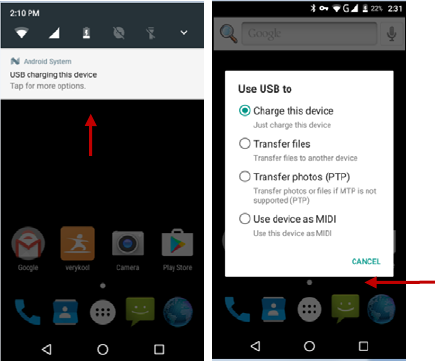
33
Connect the phone with the USB cable provided. Once connected, a connection icon will appear in the
status bar. Slide down bar and click it for more options.
Some system settings and user interface (UI) options may vary depending on final SW version.

34
FCC Caution.
§ 15.19 Labelling requirements.
This device complies with part 15 of the FCC Rules. Operation is subject
to the condition that this device does not cause harmful interference.
§ 15.21 Information to user.
Any Changes or modifications not expressly approved by the party
responsible for compliance could void the user's authority to operate the
equipment.
§ 15.105 Information to the user.
Note: This equipment has been tested and found to comply with the limits
for a Class B digital device, pursuant to part 15 of the FCC Rules. These
35
limits are designed to provide reasonable protection against harmful
interference in a residential installation. This equipment generates uses and
can radiate radio frequency energy and, if not installed and used in
accordance with the instructions, may cause harmful interference to radio
communications. However, there is no guarantee that interference will not
occur in a particular installation. If this equipment does cause harmful
interference to radio or television reception, which can be determined by
turning the equipment off and on, the user is encouraged to try to correct
the interference by one or more of the following measures:
-Reorient or relocate the receiving antenna.
-Increase the separation between the equipment and receiver.
-Connect the equipment into an outlet on a circuit different from that to
which the receiver is connected.
-Consult the dealer or an experienced radio/TV technician for help.
36
Body-worn Operation
This device was tested for typical body-worn operations. To comply with
RF exposure requirements, a minimum separation distance of 1.0 cm must
be maintained between the user’s body and the handset, including the
antenna. Third-party belt-clips, holsters, and similar accessories used by
this device should not contain any metallic components. Body-worn
accessories that do not meet these requirements may not comply with RF
exposure requirements and should be avoided. Use only the supplied or an
approved antenna.
FCC Hearing-Ai d Compatibility (HAC)
The (ATRIUM II F55L2) has been tested for hearing aid compatibility. This device has an M3 and
T3 rating. When some wireless devices are used near some hearing devices such as hearing aids and
implants, users may detect a buzzing or humming noise. Some hearing devices are more immune
than others to this interference noise. Wireless devices may also vary in the amount of interference
they generate.
37
The ratings for compatibility of digital wireless devices with hearing aids are described in the
American National Standards Institute (ANSI) C63.19 standard:
M-Rating: Phones rated M3 or M4 meet FCC requirements and are likely to generate less
interference with hearing devices than phone that are not labeled. M4 is the better/higher of the two
ratings. (ATRIUM II F55L2) is rated M3.
T-Rating: Phones rated T3 or T4 meet FCC requirements and are likely be more usable with hearing
devices’ telecoil than unrated phones. T4 is the better/higher of the two ratings.
(ATRIUM II F55L2) is rated T3.
The more immune the hearing aid device is, the less likely one is to experience interference noise
from the wireless phone. Hearing aid devices may also be rated. Adding the rating of the hearing aid
and the phone would determine probable usability:
1. Any combined rating equal to or greater than six offers the best use.
2. Any combined rating equal to five is considered normal use.
The ratings are not guarantees. Results will vary depending on the user’s hearing device and hearing
loss. If your hearing device happens to be vulnerable to interference, you may not be able to use this
device successfully. Trying out this device with your hearing device is the best way to evaluate it for
your personal needs. This device has been tested and rated for use with hearing aids for some of the
wireless technologies that it utilizes. However, there may be some newer wireless technologies used
in this phone that have not been tested yet for use with hearing aids. It is important to try the
38
different features of this phone thoroughly and in different locations, using your hearing aid or
cochlear implant, to determine if you hear any interfering noise. Consult your service provider or the
manufacturer of this phone for information on hearing aid compatibility.
For information about hearing aids and digital wireless phones
FCC Hearing Aid Compatibility and Volume Control:
http://www.fcc.gov/cgb/dro/hearing.html
Gallaudet University, RERC:
https://fjallfoss.fcc.gov/oetcf/eas/reports/GenericSearch.cfm